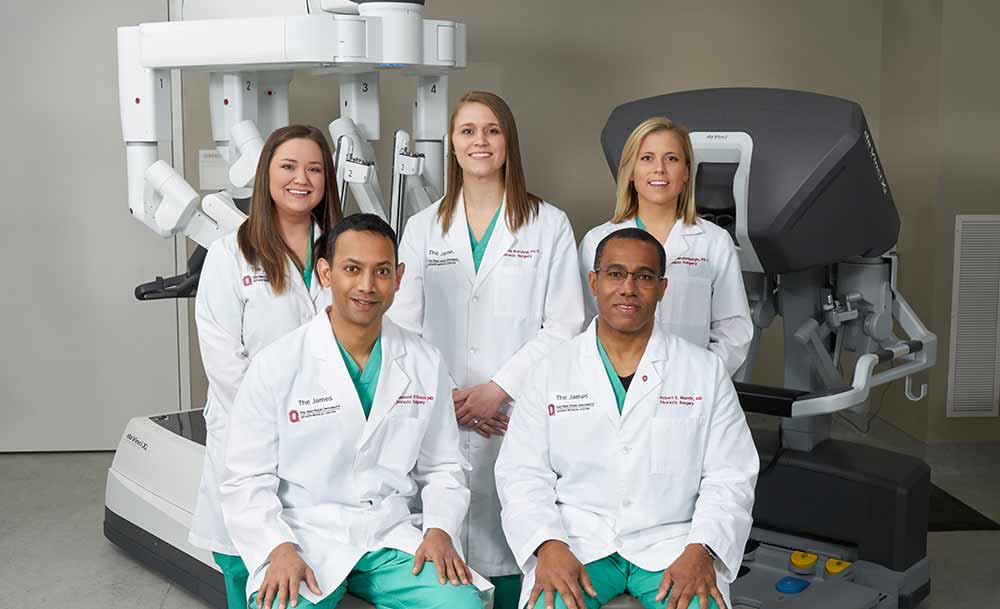Robotic-assisted surgery is the latest treatment approach available for patients diagnosed with lung cancer, esophageal cancer and mediastinal tumors at the OSUCCC - James. Equipped with an accomplished multidisciplinary team, Ohio State is recognized as an international leader in the use of minimally invasive procedures. Thoracic surgery experts at Ohio State pioneered the development of many thoracic surgical procedures used today.
As part of one of the most comprehensive robotics programs in the country, Ohio State’s robotic thoracic surgery program ranks among the country’s top four robotic thoracic surgery programs and is the leading program in Ohio. Behind the advanced technology is a multidisciplinary team of robotic-experienced surgeons, physician assistants, nurses, surgical technologists and anesthesiologists who are making a revolutionary approach to surgery and cancer treatment a reality.

As an alternative to traditional open surgery and video-assisted thoracic surgery (VATS), robotics is a transformational approach to treating thoracic cancers. As part of one of the highest volume robotic thoracic programs in the country, OSUCCC – James surgeons perform robotic procedures for patients diagnosed with thoracic cancers, including lobectomies, esophagectomies and surgeries to remove mediastinal tumors.
Traditional open thoracic surgery requires thoracotomy and, in some cases, sternotomy. Although VATS is a minimally invasive approach that has gained acceptance over the last 15 years, it involves rigid, non-articulating instruments and a limited two-dimensional visual field that combine to present surgeons with technical limitations. Robotic technology helps surgeons overcome challenges they face with open surgery and VATS, and is associated with fewer complications. For patients, that means less pain, shorter hospital stays and faster recovery.
Using the robotic approach, surgeons perform the procedures through tiny incisions between the ribs, eliminating the need for thoracotomy and sternotomy. This state-of-the-art technology equips the surgeon with magnified three-dimensional vision and greater precision. Specific to lobectomy, additional benefits of robotics include:
OSUCCC – James researchers champion translational research, contributing to outcome studies on the safety and efficacy of robotic procedures. One of the latest endeavors is a pilot study using the first cohort of robotic thoracic surgery cases to assess their comparative effectiveness to similar groups of thoracotomy and VATS patients.
As part of one of the most comprehensive robotics programs in the country, Ohio State’s robotic thoracic surgery program ranks among the country’s top four robotic thoracic surgery programs and is the leading program in Ohio. Behind the advanced technology is a multidisciplinary team of robotic-experienced surgeons, physician assistants, nurses, surgical technologists and anesthesiologists who are making a revolutionary approach to surgery and cancer treatment a reality.

Thoracic Procedures
As an alternative to traditional open surgery and video-assisted thoracic surgery (VATS), robotics is a transformational approach to treating thoracic cancers. As part of one of the highest volume robotic thoracic programs in the country, OSUCCC – James surgeons perform robotic procedures for patients diagnosed with thoracic cancers, including lobectomies, esophagectomies and surgeries to remove mediastinal tumors.
Traditional open thoracic surgery requires thoracotomy and, in some cases, sternotomy. Although VATS is a minimally invasive approach that has gained acceptance over the last 15 years, it involves rigid, non-articulating instruments and a limited two-dimensional visual field that combine to present surgeons with technical limitations. Robotic technology helps surgeons overcome challenges they face with open surgery and VATS, and is associated with fewer complications. For patients, that means less pain, shorter hospital stays and faster recovery.
Using the robotic approach, surgeons perform the procedures through tiny incisions between the ribs, eliminating the need for thoracotomy and sternotomy. This state-of-the-art technology equips the surgeon with magnified three-dimensional vision and greater precision. Specific to lobectomy, additional benefits of robotics include:
- Complete and simple resection of all mediastinal and hilar lymph nodes in the aortopulmonary window, hilar, subcarinal and paratracheal area
- Application of minimally invasive techniques to complex pulmonary resections, including large, central or radiated tumors, which extends the benefits of minimally invasive surgery to more patients
Thoracic Research
OSUCCC – James researchers champion translational research, contributing to outcome studies on the safety and efficacy of robotic procedures. One of the latest endeavors is a pilot study using the first cohort of robotic thoracic surgery cases to assess their comparative effectiveness to similar groups of thoracotomy and VATS patients.
